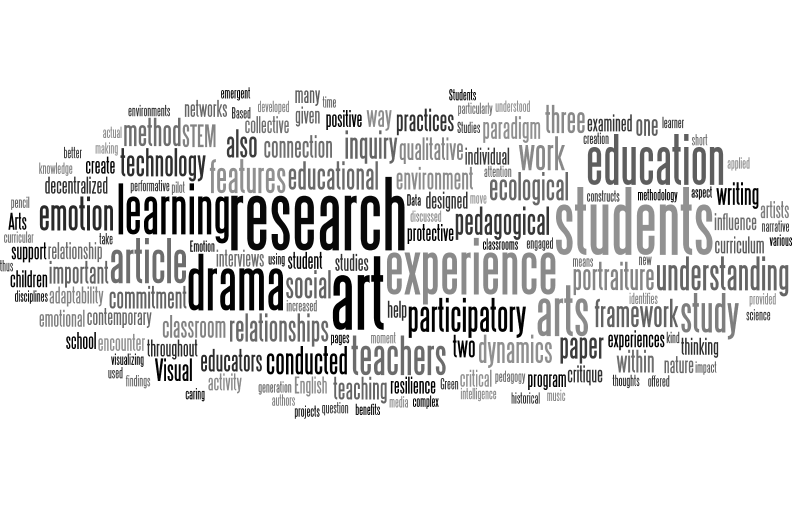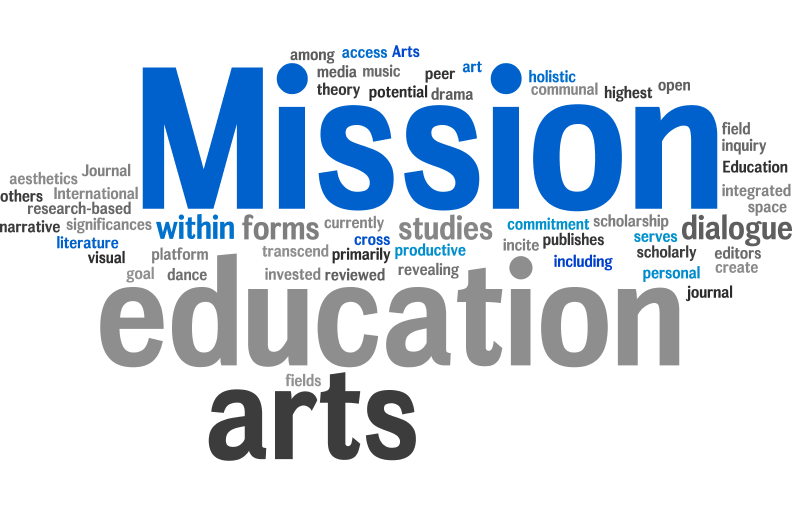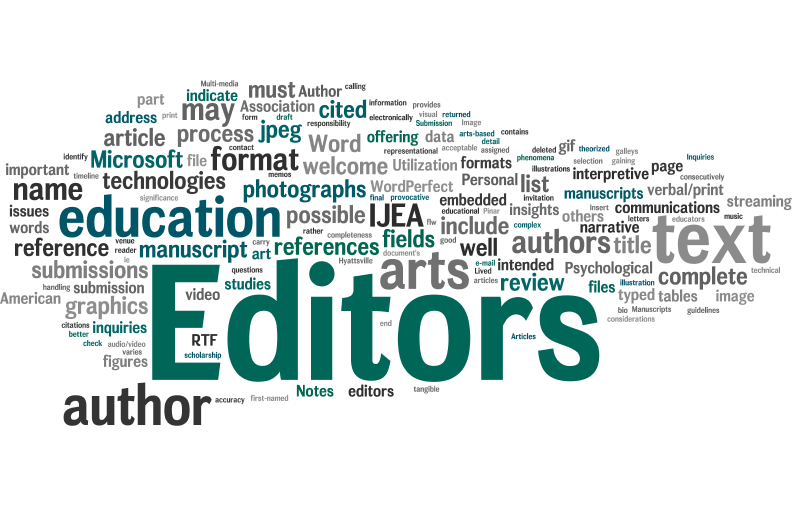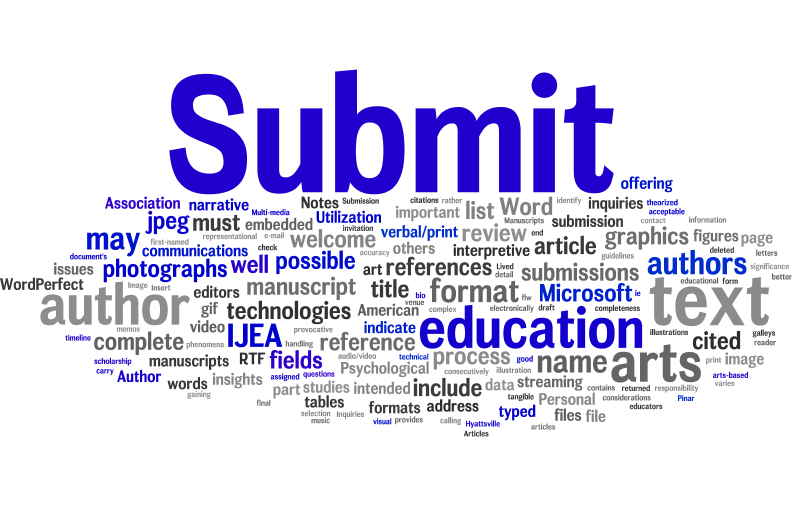2015 Volume 16
Articles and Abstracts

Articles
Volume 16 Number 1: Muccio, L. S., Reybold, L. E., & Kidd, J. (2015). Researcher-portraitists: An exploration of aesthetics and research quality.
In this article, we critique the use of portraiture as a qualitative research method, emphasizing the relationship between the fundamental aspects of portraiture and the recurring themes of research quality associated with alternative qualitative inquiry. To accomplish this goal, we conducted a study of culturally responsive practices of three first-year teachers and analyzed the data using both constant comparison and portraiture techniques. In addition to constructing poetic portraits of the teachers, we examined the intersection of aesthetics and quality research, especially in relation to researcher identity. The study-and subsequent critique of portraiture- challenges critics who question the value and goodness of the method, the same constructs emphasized by Sara Lawrence-Lightfoot in her 2005 exposition of portraiture as a social science method. Further, we critique our own methodological comfort zones, thus rejecting the either/or mentality of methodological fundamentalism exhibited both outside and within the field of qualitative research.
Volume 16 Number 2: Groman, J. L. (2015). What matters: Using arts-based methods to sculpt preservice teachers' philosophical beliefs.
This article outlines an activity that uses sculpture with pre-service teachers to facilitate the creation and articulation of their educational philosophies. The author describes the purpose and added benefits of this activity. A short review of relevant literature embeds arts based practices in historical foundations as well as in a growing current research base that encompasses depth psychology and holistic learning. A description of the activity and prompt are provided and the article concludes with thoughts on the benefits of using the arts in pre-service teacher classrooms.
Volume 16 Number 3: Henry, C., & Costantino, T. (2015). The role of cross-cultural experience in art teacher preparation.
Current research indicates that within the United States, many preservice teachers are not prepared to work with a rapidly changing student population that includes an increasing number of immigrant students with limited proficiency in English (Giambo & Szecsi, 2005/2006; Janzen, 2008; Latta & Chan, 2011). This article presents findings from a longitudinal qualitative study that examined the semester-long experiences of preservice art education students who participated in The University of Georgia Studies Abroad in Cortona, Italy program from 2003 to 2006, providing sequential art instruction to Italian children who were not English speakers. In 2010, we conducted follow-up interviews to better understand the potential long-term effects of this experience. Our findings indicated this experience gave the art education students increased cultural understanding and greater confidence in their teaching, and provided a foundational experience that they believed would help them be more successful in working with English Language Learners (ELLs) in the future.
Volume 16 Number 4: Castro, J. C. (2015). Visualizing the collective learner through decentralized networks.
Understandings of decentralized networks are increasingly used to describe a way to structure curriculum and pedagogy. It is often understood as a structural model to organize pedagogical and curricular relationships in which there is no center. While this is important it also bears introducing into the discourse that decentralized networks are also dynamic. These dynamics have been observed in nature, social behavior, and are now coded into the algorithms of social media. As art educators utilize social media to support teaching, it is important to consider the dynamics of decentralized networks and how they can influence attention and learning of a collective learner. This paper presents a method for visualizing ideation and attention drawn from an empirical study of social networking with teens in an art classroom. The visualizing of these dynamics provides art educators a method of reflecting on teaching and learning to better challenge assumptions, observe trends, and respond to the individual and the collective learner.
Volume 16 Number 5: McMahon, A., Klopper, C., & Power, B. (2015). Excellence in arts based education - One school's story.
This article reports on the implementation and outcomes of a visual art pilot program undertaken at Connell State School in creative partnership with a research team from Griffith University's School of Education and Professional Studies. Employing a framework of the four lenses developed by Seidel et al. (2009) - (learning, pedagogy, community dynamics and environment), this article investigates the notion of excellence as understood by decision makers associated with the pilot programs design and implementation.
Volume 16 Number 6: Dunn, J., Bundy, P., & Stinson, M. (2015). Connection and commitment: Exploring the generation and experience of emotion in a participatory drama.
Emotion is a complex and important aspect of participatory drama experience. This is because drama work of this kind provokes emotional responses to both actual and dramatic worlds. This paper identifies two key features of participatory drama that influence the generation and experience of emotion: commitment and connection. These features are discussed and then applied to create a framework designed to support facilitator understanding about the relationship between these features. The framework is aimed at identifying how, at any given moment in a drama, the intensity of commitment and connection impact on each individual participants experience of emotion Based on research conducted across three different contexts and with both children and adults, the authors suggest that an understanding of emotion is critical for those who are engaged in facilitating participatory drama work.
Volume 16 Number 7: Ghanbari, S. (2015). Learning across disciplines: A collective case study of two university programs that integrate the arts with STEM.
There has been some debate and research that suggests the arts are well-suited to be combined with science, technology, engineering, and math disciplines making the STEM acronym STEAM. STEM education is an educational and political priority in the United States and is valued as a means of strengthening national security and ensuring global competitiveness. The STEAM paradigm also emphasizes the importance of STEM education, but argues that the arts have the ability to open up new ways of seeing, thinking, and learning. This study aims to share student learning experiences in two established university programs that integrate an arts discipline with a STEM discipline. Student and alumni interviews are compared within a collective case study methodology. Framed by principles of sociocultural theory and experiential learning theory, this inquiry explores the role of arts integration, collaboration, and experience centered learning in knowledge creation.
Volume 16 Number 8: Brown, R. (2015). Engaging families through artful play.
Emotion is a complex and important aspect of participatory drama experience. This is because drama work of this kind provokes emotional responses to both actual and dramatic worlds. This paper identifies two key features of participatory drama that influence the generation and experience of emotion: commitment and connection. These features are discussed and then applied to create a framework designed to support facilitator understanding about the relationship between these features. The framework is aimed at identifying how, at any given moment in a drama, the intensity of commitment and connection impact on each individual participants experience of emotion Based on research conducted across three different contexts and with both children and adults, the authors suggest that an understanding of emotion is critical for those who are engaged in facilitating participatory drama work.
Volume 16 Number 9: Fels, L. & Ricketts, K. (2015). BodyHeat encounter: Performing technology in pedagogical spaces of surveillance/intimacy.
What occurs when videographer and performer encounter each other through the lens of a camera? This collaborative performative inquiry focuses on embodiment and emergent narrative as realized through an encounter between technology and the visceral bodya relational body that smells, touches, sees, hears and feels the emergent world through impulse and movement. Who performs whom as we encounter each other through technology? Does our engagement with technology limit our field of vision, or expand the pedagogical imagination? What we are beginning to recognize is a paradoxical complexity; that within surveillance is an unsuspected possibility of intimacy. With the rise in techno-mediated arts, arts educators are offered curricular and pedagogical opportunities to reinvestigate the performative encounters of those who create through and with technology.
Volume 16 Number 10: DeMichele, M. (2015). Improv and ink: Increasing individual writing fluency with collaborative improv.
This article explores how short form/comedic improvisational theater impacts the development of writing fluency. Students in all disciplines need to be able to purposefully write, however by the time students reach high school many have already given up trying to express even their own thoughts in free writing. Two quasi-experimental action research studies in two school districts, one urban and one suburban, were conducted to determine if the length of the students writing would increase after exposure to a sequence of improv story-telling and story-writing games. Data analysis revealed that both regular education and special education populations showed increases in both their word and sentence usage. The article examines how improvs collaborative nature supported by the rule of Yes, and..., may addresses deficits in both social-emotional and literacy skills that effect writing fluency.
Volume 16 Number 11: Stride, Y., & Cutcher, A. (2015). Manifesting resilience in the secondary school: An investigation of the relationship dynamic in Visual Arts classrooms.
Responding to the literature on positive adaptability, we investigated caring relationships as they manifest as protective processes in the Visual Arts classroom. Caring relationships between teachers and their students have been isolated as one of three protective factors which help promote resilience and thus positive adaptability. The Visual Arts is one of many constructs that exists as a means of understanding the process of positive adaptability, which includes emotional intelligence, intrapersonal intelligence and resilience. The study examined protective processes surrounding teacher/student relationships in the Visual Arts classroom, through a balance of both intuitive and rational inquiry. Tensions between opposites can be seen throughout the conceptual layers of the research, from the epistemology of integral consciousness and methodology of narrative inquiry through to the subject of resilience. Integral thinking was utilised as a sustained navigational tool throughout the study and such thinking was also found to be a core skill in generating caring relationships in Visual Art classrooms.
Volume 16 Number 12: Vella, R. (2015). Re-imagining classrooms: Educational environments in contemporary art.
Overlaps between contemporary artistic and pedagogical practices have become commonplace in debates and publications in various fields: from curating and museum studies to art education. Often, such overlaps – particularly pedagogical projects initiated by artists – have been studied from curatorial or art historical perspectives. This paper discusses installations produced by a handful of contemporary artists who have explored educational environments not only in terms of their spatial dynamics but also in order to question conventional understandings of knowledge transmission, literacy and power structures in education. Starting off with a practice-based example of an educational environment in art, the paper then analyses other educational environments by three contemporary artists and studies their implications for art educators.
Volume 16 Number 13: Bertling, J. G. (2015). The art of empathy: A mixed methods case study of a critical place-based art education program.
Bowers (2001) described how our ecological crisis is marked by metaphors of difference and separation. By adopting an ecological paradigm, students have the opportunity to move past harmful distinctions that have characterized relations with the earth. Instead, students can move to a deep recognition of the interconnectedness of living things. Empathy, particularly with the environment, is deeply tied to such a paradigm. To help students develop this paradigm, a critical place-based art curriculum designed and implemented in a middle school classroom. The curriculum was informed by the ecological imagination, a call for education that embraces the arts as a way to conceive of new ecological perspectives and dialogues. Drawing exercises, interviews, surveys, journals reviews, observations, and focus groups were used to investigate student experiences. Data revealed that students' ecological paradigms increased as a result of their participation. Throughout the program, students exhibited empathy with the environment as they cared for nature, developed awareness, and accepted responsibility.
Volume 16 Number 14: Brown, R., & Jeanneret, N. (2015). Re-engaging at-risk youth through art – The evolution program.
Many studies have highlighted the capacity of community arts programs to re-engage those young people considered at-risk of disconnection from future education and/or employment. Evolution is an artist-guided visual arts program established for young people challenged by mental health and social issues that aims to foster re-engagement in education and training. It was founded by a community-based youth arts studio, Signal, and in a partnership with a youth support service, has developed into an effective, strength-based model of practice that focuses on the young people’s existing capacities and positive qualities rather than setting out to improve perceived deficits. Central to the success of this program has been the commitment to relationship-building, mediated through art practice, and the opportunities afforded to connect positively with others. This paper reports on research during the formative years of this initiative and outlines the conditions that framed and impacted upon participant engagement in the Evolution Program.
Volume 16 Number 15: Guyotte, K. W, Sochacka, N. W., Costantino, T. E., Kellam, N. N., & Walther, J. (2015). Collaborative Creativity in STEAM: Narratives of Art Education Students’ Experiences in Transdisciplinary Spaces.
Current efforts to promote STEAM (STEM + Arts) education focus predominantly on how partnering with the arts provides a range of benefits to STEM students. Here we take a different approach and focus on what art and art education students stand to gain from collaborating with STEM students. Drawing on a variety of student field texts, we present three visual-verbal, constructed narratives of art education students who, in the context of a transdisciplinary design studio, were challenged to experiment with collaborative forms of creative thinking. Their stories point to STEAM as an opportunity for art students to question the notion of the ‘lone artist,’ reflect upon the tension between product and process, and expand disciplinary-based understandings of creative thinking. These potential benefits align with contemporary visual arts practices that strive to move beyond the individual and embrace dialogue, collaborative action, and interdisciplinarity as vital aspects of the creative process.
Volume 16 Number 16: Grube, V. (2015). Something Happens in Room 13: Bringing Truths into the World.
This qualitative study looks at how an art studio run by children in crisis impacts what we can learn about art and relationships. Room 13, an art studio on school grounds managed by children ages 7-11 years old, began in Scotland in the 1980’s and is now worldwide. Room 13 young artists manage the studio, raise funds, and even hire an adult studio artist. In Room 13, the children’s art making is expected to be experimental and self driven. West Rise Junior School and Hareclive Primary School in England both each have a Room 13 as well as a large population of children at risk. This research study explores how art can serve such a population.
Volume 16 Number 17: Mathewson Mitchell, D. (2015). Examining practice in secondary visual arts education.
Teaching in secondary visual arts classrooms is complex and challenging work. While it is implicated in much research, the complexity of the lived experience of secondary visual arts teaching has rarely been the subject of sustained and synthesized research. In this paper, the potential of practice as a concept to examine and represent secondary visual arts teaching is investigated. A range of practice theories are first examined to identify common themes and principles. From this conceptual foundation, four theoretical principles are developed as a framework to consider the classroom-based complexities of secondary visual arts teaching. A methodological design is then derived from this conceptual foundation. In conclusion, the potential of applying this practice-based framework to the study of secondary visual arts classrooms is considered in relation to empirical research undertaken with teachers as co-researchers.
Volume 16 Number 18: Kraehe, A. M., Hood, E. J., & Travis, S. (2015). “I'm so offended!”: Curriculum flashpoints and critical arts education.
Inspired by critical race and feminist perspectives, this paper complicates the conversation on preparing arts educators for diversity and equity. The authors ground their research on the premise that arts educators committed to challenging social inequalities must understand sociocultural influences on art, curriculum, teaching, and learning. The paper reports a qualitative study that investigated how pre-service arts educators make sense of sociocultural differences (i.e., the dynamics of race, class, gender and sexuality). Findings articulate key curriculum flashpoints that emerged when art teacher candidates engaged with sociocultural knowledge. These flashpoints include identity formation, questioning knowledge, and discourses of offense. The authors argue that these flashpoints present curricular provocations that can assist in developing the critical capacities of art educators. The conclusion explores the implications of these findings for organizing and teaching sociocultural content as foundational knowledge for arts educator preparation.
Volume 16 Number 19: Bedetti, G. (2015). Collaborative college playwriting and performance: A core course “trespassing” onto the dramatic arts.
Arts integration is relevant in the context of the increased demand for creative thinkers in a global economy. However, reaching across disciplinary boundaries is less common in higher education. Arts integration is one way that a literature class can “trespass” onto the dramatic arts. This paper reports on a study of integrating the dramatic arts into a university general education course. It addresses the relationships between literature and theater and the benefits of integrating artistic practice to cultivate creativity and enhance learning. The study investigates the process and outcomes of making a one-act play. The findings show that art and the process of creation/making promote collaboration and help students synthesize and put into practice what they have learned. Such strategies are necessary to maximize the benefits of general education and are likely to foster creative interdisciplinary approaches beyond the institution. The lack of objective quantifiable results is a study limitation.
Volume 16 Number 20: Kushins, J. (2015). Pedagogical souvenirs: An art educator’s reflections on field trips as professional development.
This essay explores the nature and importance of field trips as sites for artistic development, intellectual fulfillment, and pedagogical inspiration. The author weaves personal reflections from a professional field trip and experience teaching art education online with creative and pedagogical references to make a case for experiential learning as professional development. At a time when we experience so much of the world through screens, when school field trips are in decline due to budget cuts, and when professional development is more focused on assessment than intellectual development, this piece encourages readers to imagine how art educators, and our work with students, might be affected if we permitted ourselves and were supported in our desires to step outside our classrooms and have our own adventures in learning.
Volume 16 Number 21: Cahnmann-Taylor, M., Zhang, K., Bleyle, S. J., & Hwang, Y. (2015). “Searching for an entrance” and finding a two-way door: Using poetry to create East-West contact zones in TESOL teacher education.
Discrimination against Non-Native Speakers (NNS) of English in the TESOL profession is wide-spread and well-documented, despite significant evidence of NNS contributions as TESOL educators and scholars. Several scholars have argued for the importance of aesthetic and autobiographic narratives to democratize the TESOL field and showcase varieties of minoritized perspectives that often go unheard (Canagarajah, 2006; Nelson, 2011; Pavlenko, 2003). To this end, we present one thread of a larger study examining Chinese and Taiwanese international graduate students’ participation in arts-based pedagogies within a graduate program in TESOL. We focus on their participation in poetry classes and the ways in which these instructional experiences created opportunities for both foreign-born students and U.S.-born faculty and students alike to revise assumptions related to cultural literacy and U.S. academic norms. The aim of this article is to showcase insights from Chinese graduate students’ poems and interviews with Chinese-, Taiwanese- and U.S.-born course participants, illustrating how arts-based learning opportunities work to expand all students’ potential for double vision, creating vibrant Eastern-Western exchanges of intellectual thought and intercultural understanding.
Volume 16 Number 22: Kalyn, B., Campbell, E., McAvoy, A., Weimer, M. (2015). Dancing on thin ice: The journey of two male teacher candidates emerging as professionals within a teacher education dance program.
Teacher candidates entering the world of curricula face the realities of teaching a variety of subjects, some more conceptually foreign than others. One challenging area for teacher candidates, particularly males, is in dance education (Gard, 2008; Kiley, 2010). A teacher’s former dance experience, beliefs about who dances and why, personal identity, and the value placed on dance can shape one’s attitude towards teaching dance. This paper shares the narrative account of two male teacher candidates who faced the challenge of teaching dance in schools. These two elite hockey players experienced a shift in knowledge, attitude, skills, and perceptions towards dance by stepping outside of their comfort zone as they embarked on a professional learning journey through Project Move, an educational based dance opportunity, offered prior to their 16-week internship. They were awakened to their pedagogical responsibility, faced their biases, and responded to the call with great success. This is their story.
Volume 16 Number 23: Maziere, C. (2015). Artistic education in France: From the state to the classrooms’ practices.
Since the beginning of the 5th Republic, social demands have influenced the demand to reform the place of culture in education as a way of developing better access to French culture for all students. In recent decades, the rising number of immigrants has created administrative districts characterized by geographic contrast, social inequalities, and diverse populations, increasing the need for artistic education. This article proposes to approach the political measures that allowed the development of arts teaching in primary schools in France to understand the cultural pedagogical practices provided in primary school. In doing so, I explore the ways that experimentation with local heritage provides the necessary social dimensions that support students in their understanding of French culture, diminish unequal access to art, and how schools might be used as a tool in the process of cultural democratization.
Book Reviews
Volume 16 Review 1: Cabral, M. (2015). "Its about inspiring fantasies: A review of George Szekely's Play and creativity in art teaching.
It's a hot summer day. My three-year-old nephew and I take shelter in the shade of our beach umbrella after another swim in the sea. As I pull out my pencil to make a note on page forty-two, he eagerly grabs it from me. "I wanna draw too!" he demands. "Can I have your sketchbook please?" He flips through the pages of Play and creativity in art teaching looking for places to draw. Finding the blank pages at the end, which I was planning to use for my own notes, he draws a long eventful line. He then hands the pencil back to me, and we take turns drawing, narrating our movements out loud: "I'm picking up your line and taking it all the way up, making an edge, then a round shape, then all the way down and then it goes to have a drink of water from the river," he explains.
Volume 16 Review 2: Hendricks, K. S. (2015). Hear, listen, play! How to free your students' aural, improvisation, and performance skills.
Anyone familiar with the work of Lucy Green will not be surprised by the content of Hear, Listen, Play! How to Free Your Students' Aural, Improvisation, and Performance Skills, which serves as a practical guide for music teachers as they engage with their students in informal music learning practices (see Green, 2001, 2004, 2008). The approach outlined in this handbook reflects 15 years of multi-team research projects involving numerous students and teachers who offered time, expertise, and feedback throughout various stages of the program's development.



